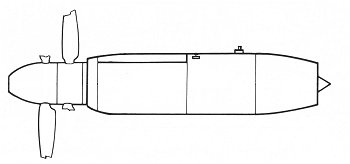


The development of the Jumo 004 was based on the Magdeburg
experiments. This development was continued by Franz Anselm at the Otto-Mader-Werke
since 1939. Anselm used several existing components to built the Jumo 004. The
compressor was built from an 8 stage axial construction of the AVA Gottingen.
The turbine blades were developed by AEG.
On the 11/10/1940 the first static test run of the engine was performed. A total
of 80 experimental Jumo 004A engines were built. The first flight was performed
on 15/3/1942 onboard a Me 110 and on 18/7/1942 the first Messerschmitt Me 262
was equipped with the new engine. The first preproduction series was the Jumo
004A-0. This engine was used for extensive flight tests, which were not satisfactory
due to material overload and failure of the fan blades.
In summer 1941 the reconstruction of the Jumo 004A for serial production was started. The first serial production engines Jumo 004B-1 was ready in early 1942 and underwent intensive tests during 1943. The Jumo 004B differed with the compressor entry, an improved stator blade design for the compressor, modified turbine entry and separate compressor discs. Also hollow turbine blades were introduced, which caused again blade failures. In summer 1943 the serial production of these engines was started at Junkers Leipzig and at the Opelwerke at Russelsheim. A total of 7916 Jumo 004B were built by Junkers Flugzeugwerke plus an unknown number of engines at Opel. Several improved series were designed up to the end of the war.
After the war the Jumo 004 was used by the Czech Air Force, which used the engine in the Avia S-91and CS-91 produced by Avia. These Jumo 004 engines were produced at CKD at Prague.
The Soviet forces captured several engines and documentation at Dessau. The Jumo 004 was further developed and became the RD-10 which was fitted in the Jak-15, La-150 and Su-9.
In France the Jumo 004 and BMW 003 were studied and fitted into the Sud-Est S.O. 6000 "Triton" and the Arsenal VG-70.
Messerschmitt Me 262
The first Me 262V1 flew first on 18/4/1941 with a Jumo 210 piston engine.
The V1 was later equipped with two BMW 003 engines. The V3 was the first Me
262 which got the Jumo 004A-0 engine. It flew first on 18/7/1942. It was followed
by V4 to V6, also equipped with Jumo 004A-0, the Me 262-V7 to V12 were already
equipped with the serial production engine Jumo 004B-0. This engine became
the later serial production engine for the Me 262. The initial production
fighter aircraft Me 262-A1 and the B1 got the Jumo 004B-1, while the bomber
series Me 262-A2 and the night fighter Me 262-B1 were later equipped with
Jumo 004B-3. The Mixed power Me262C-1 was also fitted with the Jumo 004B-3,
but the C-2 was designed with BMW 003R .
Messerchmitt P.1011
As with the Fw Ta183, a Junkers Jumo 004 was intended to be fitted in the
V-1 as the He S 011 engine was not ready.

The Jumo 012 was a special designed for the Junkers Ju 287. The engine was designed with a thrust of 6000 to 6400 lbs . Some parts were ready at the end of the war, however the prototype was not completed. When the Russians occupied Dessau, they decided to continue the Jumo 012 development A total of 15 engines were ordered for the end of 1946. The Jumo 012 prototype was ready for static tests at the end of June, but this was destroyed during tests in August . A second prototype was built in autumn 1946 and several changes were introduced. The new engine was designated Jumo 012B. In Summer 1948 the first five Jumo 012Bs were built, but as other jet engines offer more power at a more compact design, the Jumo 012 development was stopped in 1948.

Developed at Junkers Motorenbau in 1944,this was the final Junkers engine project before the end of the war. Based on the Jumo 012 it was designed with a gearing for a contra rotating airscrews, one engine was made before the wars end but it was never tested. In 1947 how ever the Soviets asked the Junkers design team in the USSR to develop this engine. In 1950 the first 022 was ready for static tests and given the designation TV-2 or TV-12, by 1951 the engine was making 5,050 hp and by 1955 7,650 hp as the TV-2M. At around this time there was a twined TV-2, given the designation 2TV-2F this engine made 12,000 hp.
In 1954 the designation was changed to the NK-12 and later this was developed in to the NK-16 which made 18,100 hp. The engine has been fitted into many Soviet aircraft such as the TU-91, TU-95, TU-142 which are still flying to day and must make the Junkers Jumo 022 the world longest lived jet engine design at nearly 60 years.